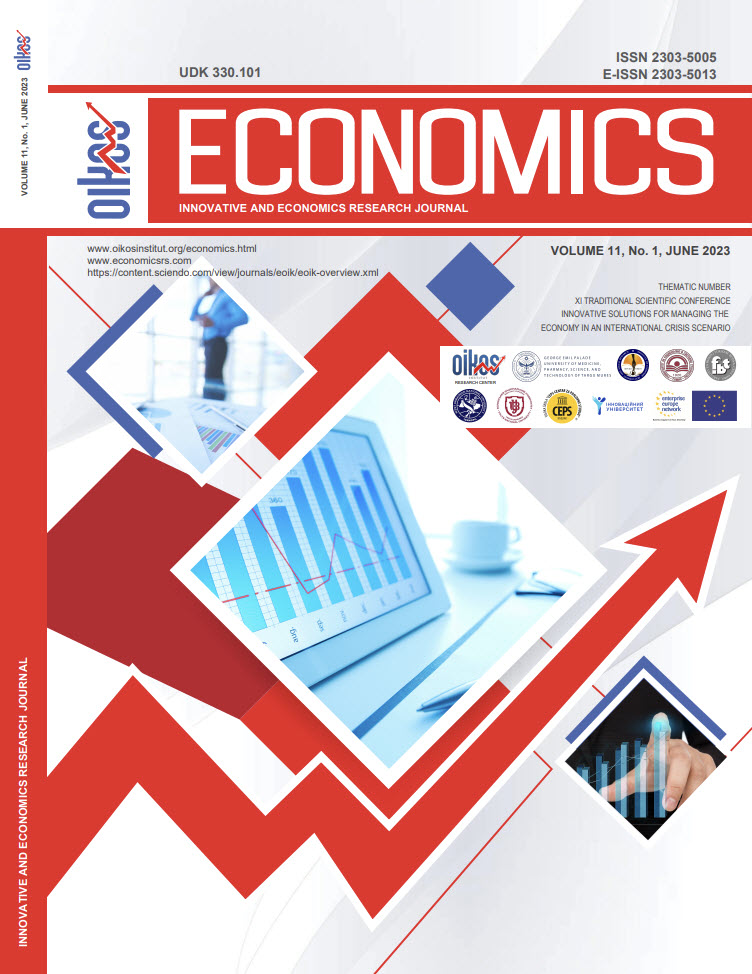THE PURCHASE BEHAVIOUR TOWARDS CONSUMER GOODS DURING ECONOMIC CRISIS – A MIDDLE EASTERN PERSPECTIVE
DOI:
https://doi.org/10.2478/eoik-2023-0001Keywords:
Consumers’ purchase behaviour, Financial Crisis, Austerity, Marketing mix, Cultural factor and Social factorAbstract
The primary purpose of this study is to develop a realistic understanding of the factors that influence consumers’ purchase behaviour towards consumer goods in the middle east region during the economic crisis, by focusing on Oman. This study has used linear regression analysis to develop a clear idea of the factors that influence consumers’ purchase behaviour towards consumer goods during the economic crisis. This study has also used Sobel test, to conduct the mediation analysis. The data was collected using a standard five-point Likert scale-based questionnaire, from a sample of 122 individuals who have recently completed their bachelor’s program in one of the four major Higher Education Institutions (HEIs) in Oman. Unlike the popular belief, this study has found the elements of the marketing mix to not exert significant influence on consumers’ purchase behaviour towards consumer goods during the economic crisis. However, the results found cultural and social factors to exert useful influence on the consumers’ purchase behaviour towards consumer goods. The study recommends that organizations need to focus more on cultural compliance and societal acceptance of their offerings, than focusing on the traditional marketing mix. While helping the organizations manufacturing or marketing consumer goods in the middle east region during the economic crisis, this study would add more value and variety to the available literature. While the findings of this study could also be used by individuals dealing with consumer products in similar markets to redefine their product offerings, by taking the cultural and social issues into consideration, this study could act as a point of reference for future researchers. This study has provided a unique perspective related to the factors that drive consumers’ purchase behaviour towards consumer goods in the middle east region, during the economic crisis. These observations could also be generalized and used in other countries that have similar cultural and social affiliations.
References
Abe, T. (2020). Dual-Labor market and unemployment compensation. ECONOMICS-Innovative and Economics Research Journal, 8(2), 21 – 35. https://doi.org/10.2478/eoik-2020-0012.
Aghdaie, M., Tafreshi, P., & Behzadian, M. (2014). Customer-oriented benefit segmentation: An integrated approach. International Journal of Business Innovation, 8, 168-189. https://ideas.repec.org/a/ids/ijbire/v8y2014i2p168-189.html
Agu, G. (2016). Perceived sales promotion transparency and customer intention to participate: Insight from student-bank customers in. Journal of Marketing Communications, 27(3), 1-18. https://doi.org/10.1080/13527266.2020.1759122
Alina, F., & Leila, V. (2012). Impact of Economic Crisis on Buying Behaviour and Marketing-Mix Tools. Ovidius University Annals, Economic Sciences Series Volume XII, 1, 931-937. https://ideas.repec.org/a/ovi/oviste/vxiiy2012i12p931-936.html.
Ang, S.W., Leong, S.M., & Kotler, P. (2000). The Asian Apocalypse: Crisis marketing for Consumers and Businesses., Long Range Planning, 33(1), 97-119. https://doi.org/10.1016/S0024-6301(99)00100-4
Al-Salamin, H., & Al-Hassan, E. (2016). The Impact of Pricing on Consumer Buying Behaviour in Saudi Arabia: Al-Hassa Case Study. European Journal of Business and Management, 8(12), 62-73. https://iiste.org/Journals/index.php/EJBM/article/view/29797/30609
Baker, J., Parasuraman, D., Grewal, D., & Voss, G.B. (2002). The influence of multiple store environment cues on perceived merchandise value and patronage intentions. Journal of Marketing, 66(2), 120-141. https://doi.org/10.1509/jmkg.66.2.120.18470
Bentler, P. M., & Chou, C. P. (1987). Practical issues in structural modeling. Sociological Methods and Research, 16, 78–117.
https://doi.org/10.1177/0049124187016001004
Bhattacherjee, A. (2012). Social science research: Principles, methods, and practices. 58.
https://digitalcommons.usf.edu/cgi/viewcontent.cgi?article=1002&context=oa_textbooks
Boone, L., & Kurz, D. (2010). Contemporary Business. 16th Edition. Willy. https://vdocuments.mx/contemporary-business.html?page=1
Briley, D., Wyer, R. S., & Li, E. (2014). A dynamic view of cultural influence: A review. Journal of Consumer Psychology, 24(4), 557–571. https://www.sciencedirect.com/science/article/abs/pii/S1057740814000114
Brown, T. A. (2006). Confirmatory Factor Analysis for Applied Research. The Guilford Press. https://psycnet.apa.org/record/2006-07729-000
Chou, T.J., & Chen, F.T.(2004). Retail pricing strategies in recession economies: The case of Taiwan. Journal of International Marketing, 12, 82-102. https://doi.org/10.1509/jimk.12.1.82.25650
Duquenne, M., N., & Vlontzos, G. (2014). The impact of the Greek crisis on the consumers’ behaviour: Some initial evidences?. British Food Journal, 116(6), 890-903. https://www.emerald.com/insight/content/doi/10.1108/BFJ-11-2012-0279/full/html
Durmaz, Y. (2014). The Influence of cultural factors on consumer buying behaviour and an application in Turkey. Global Journal of Management and Business Research: E Marketing. 14(1), 36-42. https://globaljournals.org/GJMBR_Volume14/4-The-Influence-of-Cultural-Factors-on. pdf
Fage, B., & Vasilev, A. (2021). Understanding the effect of a soft drinks industry levy on consumer well-being in the UK: First estimates. ECONOMICS-Innovative and Economics Research Journal, 9(1), 21 – 35. https://doi.org/10.2478/eoik-2021-0001
Fanack (2018). Declining Oil and Gas pushes Oman to build an Economy for the Future. https://fanack.com/economy-en/declining-oil-and-gas-in-oman~99083/
Flatters, P., & Willmott, M. (2009). Understanding the Post-recession consumer. Harvard Business Review. https://www.trajectorypartnership.com/wp-content/uploads/2013/09/HBR-article.pdf
Furaiji, F., Katuszynska, M., & Wawrzyniak. A. (2012). An empirical study of the factors influencing consumer behaviour in the electric appliances market, Contemporary Economics, 6(3), 76-86. https://doi.org/10.5709/ce.1897-9254.52
Anand, G. & Alekya, U. (2015). A Study on Consumers’ Behaviour in the Footwear Industry. Pezzottaite Journals, 4(3), 1768-1775.
https://pezzottaitejournals.net/pezzottaite/images/ISSUES/V4N3/IJASMPV4N313.pdf
Hemapatil, & Bblakkappa. (2012). The influence of culture on cosmetics consumer behaviour. Journal of Business and Management, 3(4), 41-47. https://www.readcube.com/articles/10.9790%2F487X-0344147
Huq, I., U. (2017). Impact of Oil Prices on Financial Performance of Corporate Firms: A Study of Omani Companies. International Journal of Accounting Research, 3(1), 34-41. https://www.arabianjbmr.com/pdfs/AC_VOL_3_1/4.pdf
Indumathi, N., & Ayubkhan, D. (2016). Impact of marketing mix on consumer buying behaviour. International Journal of Research in Finance and Marketing, 6(10), 43–54. https://euroasiapub.org/wp-content/uploads/2016/11/4FMOct-4125-3.pdf
Istiqomah, Y. (2016). The Influence of Marketing Mix (Product, Price, Place, and Promotion) and Service on Customer’s Decision of Using BSM Saving Products. Global Review of Islamic Economics and Business, 3(2), 73-98. https://doi.org/10.14421/grieb.2015.032-01
Jeseviciute-Ufartiene, L. (2019). Consumer Involvement in the Purchasing Process: Consciousness of the Choice. Economics and Culture, 16,126-136. https://doi.org/10.2478/jec-2019-0014
Khaniwale, M. (2015). Consumer buying behaviour. International Journal of Innovation and Scientific Research, 14(2), 278-286.
http://www.ijisr.issr-journals.org/abstract.php?article=IJISR-14-129-01
Kotler, P., & Armstrong, G. (2012). Principles of Marketing. 14th Edition. Pearson. https://nit-edu.org/wp-content/uploads/2021/09/Principles-of-Marketing-Kotler- Armstrong.pdf
Kulkarni, V. (2013). A study of the impact of retail front line sales personnel behaviour on customer buying experience in convenience stores in organized retail in India. International Journal of Advanced Reserves Management, 4, 56-64.
https://iaeme.com/MasterAdmin/Journal_uploads/IJARM/VOLUME_4_ISSUE_1/10220 130401007.pdf
Lamb, C. W., Hair, J. F., & McDaniel, C. (2009). Marketing. 11th Edition, Southwestern: Cengage Learning
Lekakis, E. J. (2015). Economic nationalism and the cultural politics of consumption under austerity: The rise of ethnocentric consumption in Greece. Journal of Consumer Culture, 17(2), 286– 302. https://doi.org/10.1177/1469540515586872
Liu, L., Wagner, W., & Sonnenberg, B. (2014). Independent freshman admission and educational inequality in the access to elite higher education. Chinese Sociological Review, 46(4), 41–67. https://doi.org/10.2753/CSA2162-0555460403
Mansoor, A., & Jalal. A. (2011). The Global Business Crisis and Consumer Behaviour: Kingdom of Bahrain as a Case Study. International Journal of Business and Management. 6(1), 104-115. https://doi.org/10.5539/ijbm.v6n1p104
Maria, H., Anne, H., & Pia, P. (2015). An exploration of how mature women buy clothing: empirical insights and a model. Journal of Fashion Marketing &Management, 15(1), 108-122. https://doi.org/10.1108/13612021111112377
Mirabi, Akbariyeh, & Tahmasebifard (2015). A study of factors affecting on customers purchase intention. Journal of Multidisciplinary Engineering Science and Technology 2, 18-28. https://www.jmest.org/wp-content/uploads/JMESTN42350395.pdf
National Center for Statistics and Information. (2015). Statistical yearbook. 43–2015. Oman: National Center for Statistics and Information. https://www.ncsi.gov.om/Elibrary/Pages/LibraryContentDetails.aspx?ItemID=lffQDcPJGNjEE5Xix4WK2g%3D%3D
NCSI (2014). Oman going through turbulent times. In Cornock,O (2014). Value Driven Market, The Report Oman, 2014.
https://oxfordbusinessgroup.com/reports/oman/2014-report
Noel, H. (2017). Basics marketing: Consumer behaviour.Bloomsbury Publishing Nunnally, J. C., & Bernstein, I. H. (1994). Psychometric theory. 3rd Edition. McGraw-Hill. https://doi.org/10.1177/014662169501900308
Orji, M., Sabo, B., Abubakar, M., & Usman, A. (2017). Impact of Personality on Consumer buying behaviour towards textile material in Southern Nigeria. International Journal of Business and Economics Research. 6(1), 7-18.
https://doi.org/10.11648/j.ijber.20170601.12
Patrick, L., lyiegbuniwe, P.I., Ighomereho, S.O., & Ganiyu, R.A. (2014). A Review and Integration of the Partial Models of Consumer Behaviour. https://www.semanticscholar.org/paper/A-Review-and-Integration-of-the-Partial-Models-of-Ladipo-lyiegbuniwe/0b888b3dab254dc07622f31e27877776fb5eafe8
Quelch, J., & Jocz, K. E. (2009). How to market in a downturn. Harvard Business Review, 4. https://hbr.org/2009/04/how-to-market-in-a-downturn-2
Radukic, S., Mastilo, Z., Kostic, Z., & Vladusic, L. (2019). Measuring of goods and labor markets efficiency: Comparative study of Western Balkan Countries. Montenegrin Journal of Economics, 15(2), 95-109. https://www.researchgate.net/publication/340935431_Measuring_of_The_Goods_and_Labor_Markets_Efficiency_Compara-_tive_Study_of_Western_Balkan_Countries
Rowly, E., & Griber, R. (2019), Slump in household spending highlights the effect of austerity measures on consumers. Available at https://www.telegraph.co.uk/finance/economics/8084293/Slump-in-household-spendinghighlights-the-effect-of-austerity-measures-on-consumers.html
Riemer, H., Shavitt, S., Koo, M., & Markus, H. R. (2014). Preferences don’t have to be personal: Expanding attitude theorizing with a cross-cultural perspective. Psychological Review,121(4), 619-648. http://dx.doi.org/10.1037/a0037666
Salim, A. S., Al-Jadharmi, M. A. H., & Al-Handhali, S. N. S (2015). A Study on Consumer Preferences towards Selected Local Omani (FMCG) Products. https://pdfs.semanticscholar.org/6eb6/d26c6637fb9804fe2360544f49878d5f6860.pdf
Shah, A. (2010). Factors Affecting Consumer Behaviour. Available at https://productmanagement.buzz/index.php/2010/07/27/factors_affecti/
Shallu, G., & Sangeeta. (2013). Impact of promotional activities on consumer buying behaviour: A study of cosmetic industry. International Journal of Commerce, Business and Management [Online]. 2(6). http://www.iracst.Org/ijcbm/papers/ vol2no62013/11vol2no6.pdf
Sharma, P. (2017). To study the consumers buying behaviour towards clothing Retail Brands in Ahmedabad city.
https://ideas.repec.org/p/sek/iacpro/4607841.html
Siddhique, H. (2018). Reshaping the government’s demand driven model of oman’s macro-economic landscape. The Political Economy of Muslim Countries. 68. Cambridge Scholars Publishing. https://www.researchgate.net/publication/327777026_Reshaping_the_Government’s_Demand_driven_model_of_Oman’s_Macroeconomic_landscape
Tavassoli, N. (2021). The transition of son preference: Evidence from southeast Asian countries. ECONOMICS-Innovative and Economics Research Journal, 9(1), 43 – 67. https://doi.org/10.2478/eoik-2021-0010
Theodoridou, G., Tsakiridou, E., Kalogeras, N., & Mattas, K. (2019). The Impact of the Economic Crisis on Greek Consumer Behaviour towards Food Consumption. International Journal of Food System Dynamics, 10 (3), 298‐314. https://www.researchgate.net/publication/340609442_The_Impact_of_the_Economic_Crisis_on_Greek_Consumer_Behaviour_towards_Food_Consumption
Times News Service (2018). Middle east consumers becoming goss roots. https://timesofoman.com/article/56498-middle-east-consumers-becoming-more-cost- conscious
The New Arab (2019). Low Oil Prices Halt Infrastructure Projects and Job Promotions.
https://english.alaraby.co.uk/english/news/2019/4/22/low-oil-prices-halt-oman-projects- and-job-promotions. Accessed on 10th August 2020
Downloads
Published
How to Cite
Issue
Section
License
Copyright (c) 2023 ECONOMICS - INNOVATIVE AND ECONOMICS RESEARCH JOURNAL

This work is licensed under a Creative Commons Attribution-NonCommercial-NoDerivatives 4.0 International License.























